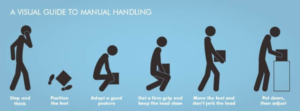Did you know?
Every year more than a third of all work-related illnesses reported to the Health and Safety Executive (HSE) or local authorities are due to manual handling – the transporting or supporting of loads by hand or bodily force.
The majority of such accidents cause back injury and lead to, on average, 17 days off work. In some cases the person never recovers. This massive human and economic cost is not just caused by the handling of heavy loads. Many injuries arise through the repetitive movement of light or difficult-to-handle loads.
Loads themselves can be as diverse as a box of goods, an animal or a patient, and the environments in which injuries occur include everything from a factory, office and hospital to a bank or building site – or even while making deliveries.
The Manual Handling Operations Regulations 1992 (MHOR) exist to help prevent many of these injuries. Unfortunately, for all parties involved injuries do happen, affecting both individuals involved and creating cost and disruption to a business.
The HSE Health and Safety statistics for 2017/18 reported:
- 1.4 million working people suffering from a work-related illness
- 2,595 mesothelioma deaths due to past asbestos exposures (2016)
- 144 workers killed at work
- 555,000 injuries occurred at work according to the Labour Force Survey
- 71,062 injuries to employees reported under RIDDOR
- 30.7 million working days lost due to work-related illness and workplace injury
- £15 billion estimated cost of injuries and ill health from current working conditions (2016/17)
Source: www.HSE.gov.uk/statistics
So what can you do to stop these types of costly accidents?
As part of managing the health and safety of your business, you must control the risks in your workplace. The first steps are to avoid manual handling (e.g. does the item have to be moved or can the activity be done safely where it is?) and ensure good handling when lifting objects to minimise the risk of injury. The second step is assess the risks in your workplace.
1. Good handling – a visual guide
To promote best practice in your workplace, follow these simple steps when training people in safe manual handling.

Further guidelines on good handling can be found in our downloadable guide.
2. Assess the risks in your workplace – considerations and things to look for when making a risk assessment
This process is known as a risk assessment and it is something you are required by law to carry out. With some careful observations and evaluations of your employees’ work space you can make the decision as to whether manual handling is right for your day-to-day environment. These can be split into three sections:
2.1. The tasks your workers complete: If they involve holding loads away from the body, carrying them long distances, up stairs or twisting, stooping or reaching then you should assess if these tasks could be better completed mechanically.
2.2. The loads that your employees are expected to move need to be assessed: If they are very hot, hard to hold or very heavy and need strenuous pushing and pulling, you might want to consider mechanical help for moving these loads.
2.3. The working environment: Perhaps you need to move goods over floors, which involves your staff walking up and down stairs repeatedly, this may result in slips, trips or falls. If there is poor lighting, a high footfall in the space where your goods need to be moved, or restricted space, then there is a better solution than manual handling and carrying loads up stairs or through busy areas.
If the answer is yes to a lot of these questions, it is highly recommended that you consider installing a service lift or goods lift to help lighten the loads, speed-up productivity and, most of all, make your workplace much safer for your employees.
To find out more about providing the safe handling of goods download our comprehensive guide.
